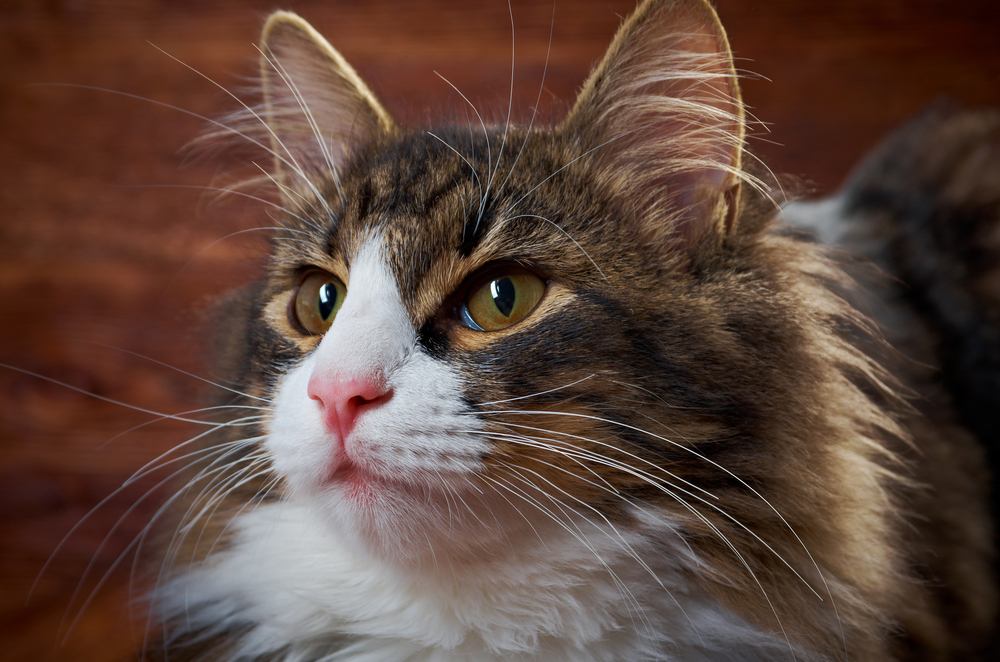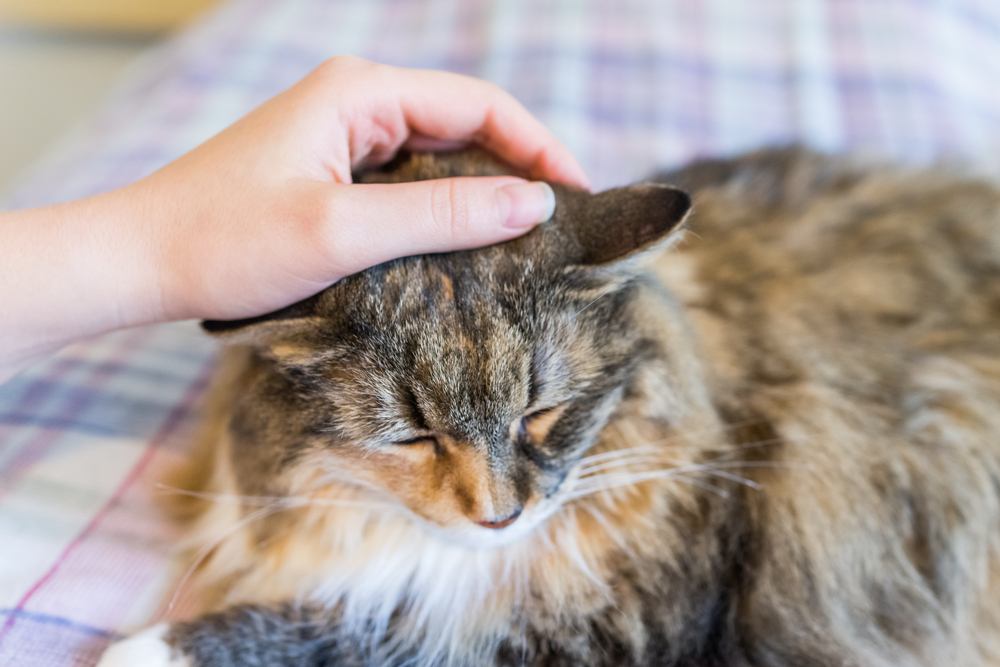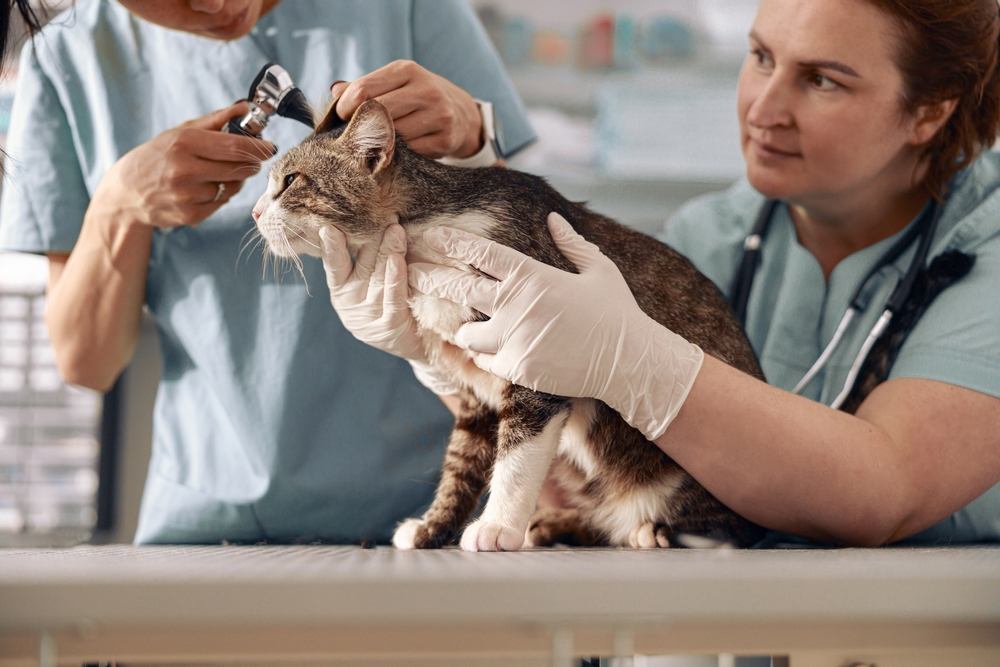
If you’re a cat parent, you probably spend a lot of time petting or cuddling them, and generally in contact with them, so you subconsciously know how they normally feel. Have you ever gone to stroke your cat’s head and found that your cat’s ears feel warm? This could mean that your cat has a fever, ear problems, or just that they’ve been soaking up some sun or your hands are particularly cold.
In this article, we’ll cover the different causes of warm ears in cats – when it’s a sign of a problem and when it might be a red herring. Most importantly, we’ll explain what to do if your cat’s warm ears does seem to be a sign that they’re unwell.
Possible Causes of Warm Ears in Cats
Below you’ll find some potential reasons why your cat’s ears might feel warm to the touch:
Fever
A fever means that your cat’s body temperature is higher than normal, and this might be obvious when you touch them. Your cat’s fur can make it difficult to feel their actual body temperature, so areas with less fur – like their ears, nose, and paws – are where it’s most noticeable.
If your cat has a fever, it could be caused by a viral or bacterial infection, and depending on the part of the body that’s affected, you might notice a variety of other symptoms. For instance, if your cat has gastroenteritis (an infection of the stomach and intestines) you might notice vomiting, diarrhea, or both. If they have cat flu, they might be sneezing with a nasal discharge and runny eyes. On the other hand, if your cat has an infected cat bite that has formed an abscess on their leg, you might see a swelling or wound, and your cat might be limping.
Sometimes, there are no specific symptoms other than fever, and this is known as ‘pyrexia of unknown origin.’ Most of these cases are caused by viral infections, but other rarer causes include inflammation, immune-mediated conditions, and cancer. You can find out more about fever in cats by reading our article.
Allergies
Allergies in cats can affect their ears as well as their skin, which could lead to their ears feeling warm to the touch. Potential allergens include food, fleas, molds, dust mites, and pollens, and if your cat is affected you might notice that they have a skin rash called miliary dermatitis, which looks like small red bumps or scabs. While it’s unusual for allergies to affect just the ears and not the skin as a whole, it does happen.
If your cat has a more severe allergic reaction that causes swelling of their face or breathing distress, you might also notice their ears feel warm due to an increase in blood flow.
Heatstroke

Heatstroke most commonly occurs in cats accidentally locked into a shed, garage or greenhouse.
Sadly, heatstroke still occurs relatively commonly in dogs despite publicity over recent years, but did you know it can also affect cats? Heatstroke happens when a cat’s temperature is driven up by the environment and is most common on really hot summer days, especially if your cat is unable to move somewhere cool and shady.
If your cat has heatstroke, they will feel warm to the touch, especially on their ears, paws, and nose. Their breathing will be more rapid, and they might be open-mouth breathing (or panting). You might notice that their gums are more red than normal, or that they have a purple-blue tinge. If you suspect that your cat might have heatstroke, contact your veterinarian without delay.
Ear Mites
Ear mites are external parasites that live in the ear canal and cause discharge and itchiness. They commonly affect young kittens or older cats who are immunocompromised, and they transmit between cats very easily.
Ear mites can cause intense itching which causes your cat to scratch their ears relentlessly. This self-trauma causes even more inflammation and is why if your cat is affected you might notice that their ears feel warm. Other symptoms of ear mites in cats include hair loss and wounds on the backs of the ears, brown wax-like discharge inside the ears, and lots of scratching. However, some cats with ear mites show very mild signs.
Ear Infection
Just like ear mites, ear infections in cats can cause their ears to feel warm to the touch. This is due to the inflammation within the ear canal, as well as self-trauma from your cat scratching and shaking their head. Ear infections can be caused by bacteria or yeast infections, but foreign material, growths or polyps within the ear canal can cause similar signs.
If your cat has an ear infection, as well as warm ears you’ll probably notice them shaking their head and scratching their ears with their paws. They may lose hair from around their ears, and you might notice raw skin from the self-trauma.
Non-Medical Reasons
There are a few non-medical reasons why your cat might seem to have warm ears. Firstly, if your cat has been lying in the sun or by the radiator, their ears might feel warm for a little while, but this shouldn’t persist when they’re somewhere cooler. Similarly, if your hands are cool because you’ve been outside or it’s cold, you might think that your cat feels warm relative to your hands, when actually their temperature is normal.
This is why it’s important to measure your cat’s temperature (usually performed by the veterinary team, but safe to try if you know what you are doing and have help) to be certain whether the warm ears are subjective or a true sign of a problem. For more information, read Why Does My Cat Feel Hot to Touch: When to Worry.
When To Call the Vet
If your cat’s ears feel warm but they’re otherwise acting completely normally with no sign of illness, it could be that they have been lying somewhere warm. Take them somewhere cool and check them again in half an hour.
If they still feel warm to the touch, consider taking their temperature (if you feel able to do so safely) or booking a reassurance appointment with a veterinarian. A cat’s normal body temperature is 97.7 to 102.2 degrees Fahrenheit (36.5 to 39.0 degrees Celsius).
If your cat’s ears feel warm but they have other symptoms like vomiting, diarrhea, breathlessness, lethargy, or loss of appetite, it’s important that you contact the veterinary clinic and make an appointment to get them checked.
Taking Your Cat’s Temperature
Your veterinarian will usually take your cat’s temperature using a rectal thermometer, but a cat’s ear temperature is also occasionally used. Mostly, there’s no need for you to take your cat’s temperature yourself, but you may feel that you want to learn.
Before attempting to take your cat’s temperature using either method, it’s best to ask your cat’s veterinary team to demonstrate. Remember, you’ll need an extra pair of hands to help and if you’re using the rectal method you’ll need to use some lubricant.
Treating Cats With Warm Ears

Veterinarians can safely examine the inside of a cat’s ear and ear canal using an otoscope.
- Before you try to treat your cat with warm ears at home, it’s important to seek veterinary advice to ensure that they don’t have an underlying condition that requires treatment.
- If your cat is well and behaving normally but has warm ears, it’s unlikely that they require any treatment. Take them somewhere cool and check them again after a short while to see whether their temperature feels normal.
- If your cat has a fever, your veterinarian will examine them to determine the underlying cause. They will then prescribe treatment which might include anti-inflammatory and antibiotic medications. If there is no obvious reason for the fever, or no response to treatment, they may run additional tests.
- If your cat feels warm and is showing signs of heatstroke, like panting, rapid breathing, or collapse, it’s important to start cooling them as you make your way to the veterinary clinic. Lowering their temperature will help to reduce the risk of hyperthermia causing serious or permanent damage to their brain or other organs.
- Cat ear infections and ear mites can be treated with antibiotic drops and cleaners. It’s important not to use any drops that weren’t prescribed for your cat by your veterinarian, or attempt to insert anything into the ears, because the tissue within the ear canal is very fragile and easily damaged.
- To help your cat with warm ears feel better once veterinary treatment is underway, ensure that they have somewhere cool to rest and ensure free access to cool drinking water.
Prevention of Warm Ears in Cats
Sadly, it’s impossible to prevent your cat from getting an infection. Their vaccinations will protect them from some more serious infections, but it’s still likely that they will be affected by an infection at some point in their life. Similarly, ear infections and allergies happen. In these situations, the most important thing you can do for your cat is to spot the signs that things aren’t right early and seek veterinary treatment to get your cat feeling better as soon as possible.
Many parasite treatments will also cover against ear mites, and using these treatments regularly, as per the instructions, will help to ensure that your cat isn’t affected.
When it comes to heatstroke, cats are pretty good at avoiding it. They’ll move out of the sun or heat if they are able to when they’ve had enough. Heatstroke is more often a problem when cats are inadvertently locked in outbuildings and sheds or have mobility issues that make them less likely or unable to move to a cooler spot.
Also Read: Cat Ear Positions & What They Mean







